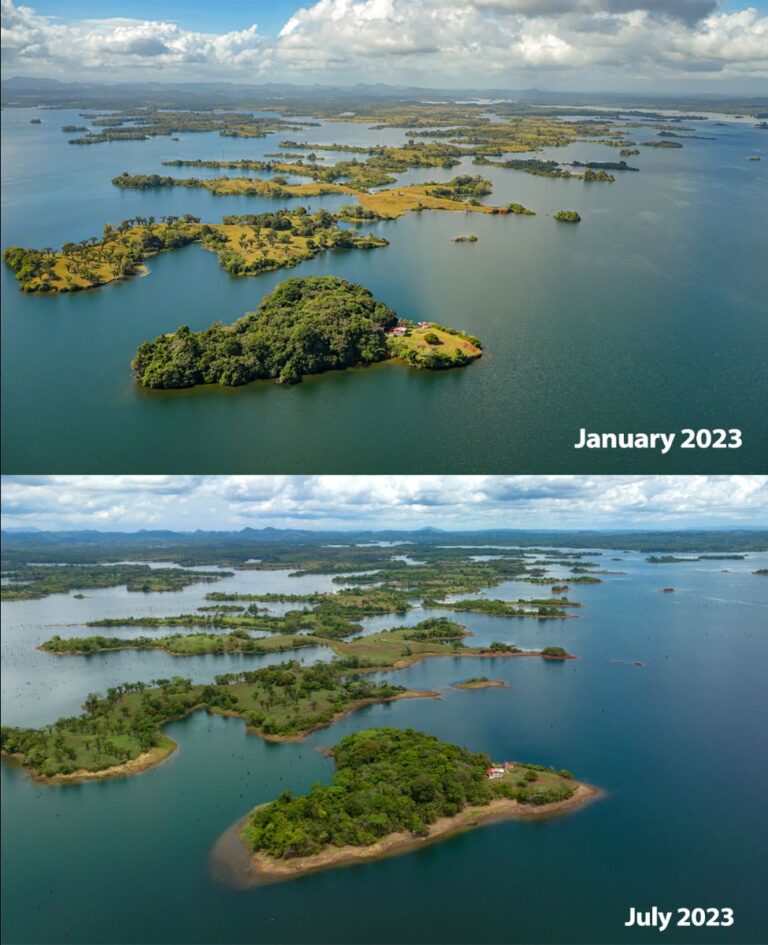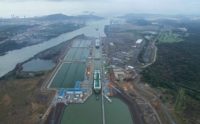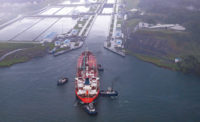Water Conservation
Severe Drought Prompts Panama Canal Passage Limits
Work continues on preparing bid package for new water management system

Even with the water-saving basins incorporated into the new set of locks, more than 50 million gallons of freshwater is lost from the Panama Canal with every ship's passage.
Photo courtesy the Panama Canal Authority
A drought of historic proportions in Central America has prompted the Panama Canal to impose restrictions on shipping traffic due to falling water levels in the waterway as well as the need to conserve the country's declining reserve of freshwater.
On July 22, the Panama Canal Authority (known by it's Spanish-language acronym ACP) announced a limit of 44 ft on the drafts for vessels transiting the waterway and capped the number of transits each day at 32, about 10% cut in the usual traffic for the canal. The restrictions are expected to last several months.
Rainfall is critical to maintaining adequate levels in two artificial inland lakes that supply the approximately 52 million gallons of fresh water necessary to move each vessel through the canal’s twelve locks. There has been scant precipitation since the normal end of Panama’s dry season in April, and with current El Nino weather pattern expected to last into next year, the possibility of a respite is remote.
The current drought, which ACP says is the worst in 70 years, is straining reservoir capacity. Of particular concern is Gatun Lake, which in addition to providing water for canal purposes, also supplies half of Panama’s drinking water.
“This is an issue that the Panama Canal has been warning and preparing for; however, we could not have predicted exactly when the water shortage would occur to the degree that we are experiencing now,” said Canal Administrator Ricaurte Vásquez Morales in a statement.
The draft limit is expected to heavily impact Neopanamax bulk carriers, which, with drafts of up to 50 ft, utilize the canal’s third set of locks, completed in 2016. But as the Panama Canal as a whole handles 6% of global maritime traffic, vessel limits could have a ripple effect on seaborne commerce between the U.S. and East Asia.
Even before the ACPs restrictions went into effect, transit waiting times had lengthened to nearly two weeks. At a mid-July industry conference in Vancouver, Corey Grindal, CEO of liquefied natural gas provider Cheniere Energy, told reporters that market conditions no longer justified long waits for his company’s vessels to access the canal.
Though Panama has experienced numerous droughts since the original Panama Canal was completed in 1914, their increasing frequency and severity in recent years have presented new risks to the strategically important channel. ACP says the most recent intense drought occurred just three years ago, when a 20% decrease in rainfall caused the supply reservoirs to drop far below normal levels.

The lack of rain over the past six months has lowered the water level of Gatun Lake
which is critical to the operations of the Panama Canal and provides drinking water for the country.
Photo courtesy the Panama Canal Authority
ACP says it has implemented numerous operational and conservation measures since the beginning of 2023 to cut water use, including increased use of storage basins in the Neopanamax locks to recover at least some of the 52 million gallons that is flushed into the sea following each transit.
With the need for longer-term solutions growing, the agency in 2020 issued a tender pre-qualify prospective bidders to engineer, design and construct a new water management system that would guarantee an additional 1.4 billion cubic meters to support both Canal operations and local potable water needs for the next 50 years.
Estimated at the time to cost $2 billion, the tender drew more than 250 respondents, with many expressing concerns about the program’s risks. After halting the tender in mid-2021, ACP contracted with the U.S. Army Corps of Engineers’ Southeastern Division to re-define the scope of work for a portfolio of projects to be included new bid package.
Scheduled for completion next year, the Corps’ work includes providing “special services for the review of the studies carried out, as well as the identification and performance of those required to evaluate possible alternatives, develop models and simulations and prepare conceptual designs.”



